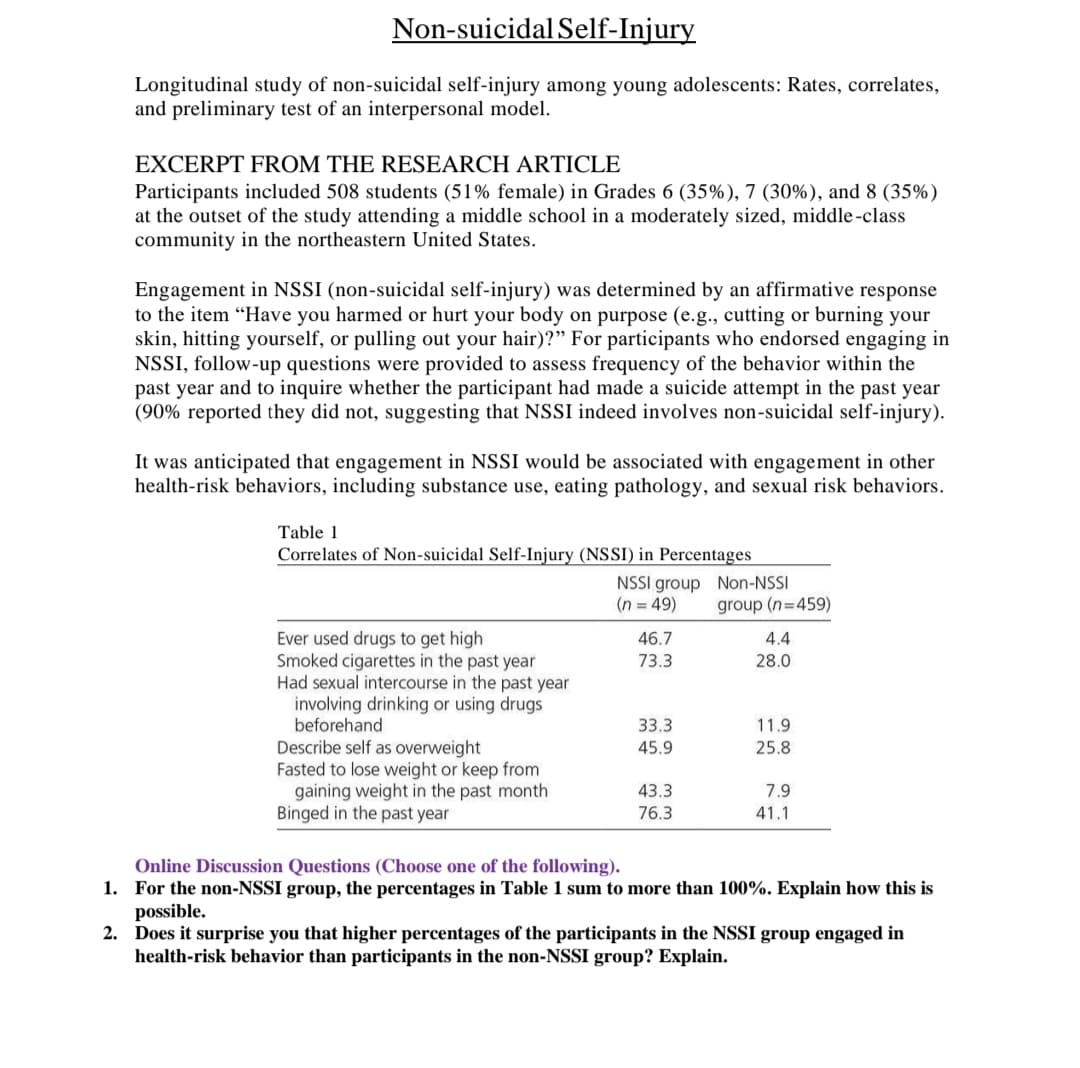Participants included 508 students (51% female) in Grades 6 (35%), 7 (30%), and 8 (35%) at the outset of the study attending a middle school in a moderately sized, middle -class community in the northeastern United States. Engagement in NSSI (non-suicidal self-injury) was determined by an affirmative response to the item "Have you harmed or hurt your body on purpose (e.g., cutting or burning your If nullina out hoir)? Eo
Participants included 508 students (51% female) in Grades 6 (35%), 7 (30%), and 8 (35%) at the outset of the study attending a middle school in a moderately sized, middle -class community in the northeastern United States. Engagement in NSSI (non-suicidal self-injury) was determined by an affirmative response to the item "Have you harmed or hurt your body on purpose (e.g., cutting or burning your If nullina out hoir)? Eo
Big Ideas Math A Bridge To Success Algebra 1: Student Edition 2015
1st Edition
ISBN:9781680331141
Author:HOUGHTON MIFFLIN HARCOURT
Publisher:HOUGHTON MIFFLIN HARCOURT
Chapter4: Writing Linear Equations
Section: Chapter Questions
Problem 14CR
Related questions
Question
Please read the article and answer the following questions thanks

Transcribed Image Text:Non-suicidal Self-Injury
Longitudinal study of non-suicidal self-injury among young adolescents: Rates, correlates,
and preliminary test of an interpersonal model.
EXCERPT FROM THE RESEARCH ARTICLE
Participants included 508 students (51% female) in Grades 6 (35%), 7 (30%), and 8 (35%)
at the outset of the study attending a middle school in a moderately sized, middle-class
community in the northeastern United States.
Engagement in NSSI (non-suicidal self-injury) was determined by an affirmative response
to the item "Have you harmed or hurt your body on purpose (e.g., cutting or burning your
skin, hitting yourself, or pulling out your hair)?" For participants who endorsed engaging in
NSSI, follow-up questions were provided to assess frequency of the behavior within the
past year and to inquire whether the participant had made a suicide attempt in the past year
(90% reported they did not, suggesting that NSSI indeed involves non-suicidal self-injury).
It was anticipated that engagement in NSSI would be associated with engagement in other
health-risk behaviors, including substance use, eating pathology, and sexual risk behaviors.
Table 1
Correlates of Non-suicidal Self-Injury (NSSI) in Percentages
NSSI group Non-NSSI
(n = 49)
group (n=459)
Ever used drugs to get high
Smoked cigarettes in the past year
Had sexual intercourse in the past year
involving drinking or using drugs
beforehand
46.7
4.4
73.3
28.0
33.3
11.9
Describe self as overweight
Fasted to lose weight or keep from
gaining weight in the past month
Binged in the past year
45.9
25.8
43.3
7.9
76.3
41.1
Online Discussion Questions (Choose one of the following).
1. For the non-NSSI group, the percentages in Table 1 sum to more than 100%. Explain how this is
possible.
2. Does it surprise you that higher percentages of the participants in the NSSI group engaged in
health-risk behavior than participants in the non-NSSI group? Explain.
Expert Solution
This question has been solved!
Explore an expertly crafted, step-by-step solution for a thorough understanding of key concepts.
This is a popular solution!
Trending now
This is a popular solution!
Step by step
Solved in 2 steps

Recommended textbooks for you

Big Ideas Math A Bridge To Success Algebra 1: Stu…
Algebra
ISBN:
9781680331141
Author:
HOUGHTON MIFFLIN HARCOURT
Publisher:
Houghton Mifflin Harcourt

Big Ideas Math A Bridge To Success Algebra 1: Stu…
Algebra
ISBN:
9781680331141
Author:
HOUGHTON MIFFLIN HARCOURT
Publisher:
Houghton Mifflin Harcourt